 |
||
|
||
| ||
Since our last review on the Pentium 4 its frequency was raised by 200 MHz - it is a substantial event, especially for the Pentium 4. Why "especially"? Because its core is designed in such a way that only a frequency increase can help it. The processing of some applications on the Pentium 4 can be compared with driving a "Formula-1" on the city streets - it is quite fast but it misses turnings :) That is why the only thing left to do is to increase the speed to have an opportunity to return quickly to the missed turning. Today the processor is going to be compared with its two major competitors - the Pentium III 1.13 GHz and AMD Athlon. We have assembled a heap of configurations: 3 different Pentium 4 processors work on the same platform - i850 + RDRAM, and the Athlon (1.33 GHz) works on two platforms: VIA KT133A + PC133 and AMD-760 + PC2100 DDR. The test system configuration:
Software:
We have used a great deal of tests due to significant differences in the architecture of the processors in question. We won't describe the standard Quake III / SYSmark 2000 / ZDM Winstone 2001 applications in detail since everybody knows them well. Apart from them we used 3Dstudio MAX R3.1 and SPEC viewperf 6.1.2. 3DStudio MAX (the application is meant for heavy calculations). SPEC viewperf is an avowed test for estimation of the performance of computation systems working with heavy professional OpenGL-applications of CAD/CAM type. Its results are influenced primarily by the memory speed, and that is why the most significant comparison in the respect is between Pentium 4 + PC800 RDRAM and Athlon + PC2100 DDR SDRAM. Quake III Fast: 640x480x16 and 800x600x16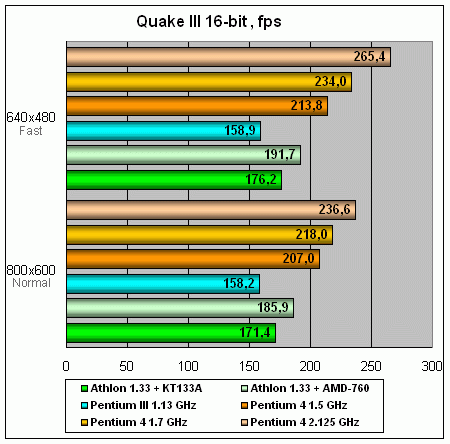 Quake III at 16-bit color and low resolutions shows the memory access speed perfectly. Provided that the processor is powerful enough, it is the only factor limiting the fps. That is why it is clear why the Pentium 4 has taken the lead here - a 400 MHz FSB and dual-channel RDRAM. As for the Athlon systems, the clock speed of the processor was the same in all cases, that is why the memory speed depended only on its type, FSB frequency and chipset capabilities. The PC2100 DDR module is really faster and the PC133 one is noticeably slower. The Pentium III 1.13 GHz has fallen behind all the systems - it has a lower frequency and a weaker bus (Pentium 4 - 400 MHz, Athlon EV-6 - 266 MHz, Pentium III AGTL+ - 133 MHz). Quake III: 1024x768x16 HQ and 1280x1024x16 Full Option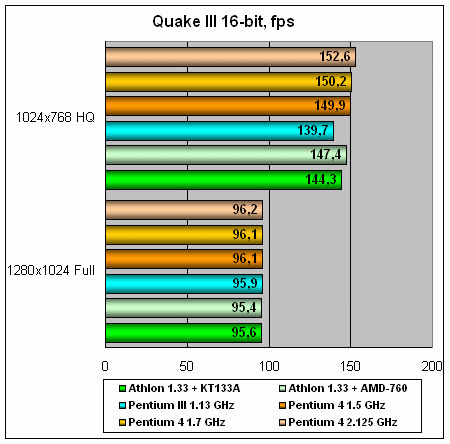 The second diagram is just a logical conclusion of the first one. At such high resolutions the video card starts playing the role of a deterrent, but on the other hand, the texture volume is not that big, that is why the texture transfer speed in the channel RAM --> AGP --> VIDEO CARD doesn't influence the final results much as it does at 32-bit color. As a result, at 1024x768 resolution all the systems have still enough strength to compete, though without spirit, and when coming to Full Option and at 1280x1024 everything becomes clear - the Pentium 4 + RDRAM is a bit ahead, the others are almost at the same level. The Pentium 4 is still showing its advantage it had in the previous test, though the gap is not that big due to an increased role of the video card. At 1024x764x16 HQ the Pentium III is falling behind - well, it falls everywhere when something depends on the subsystem "processor + chipset + memory" :) Quake III: 800x600x32 Normal, 1024x768x32 HQ and 1280x1024x32 Full Option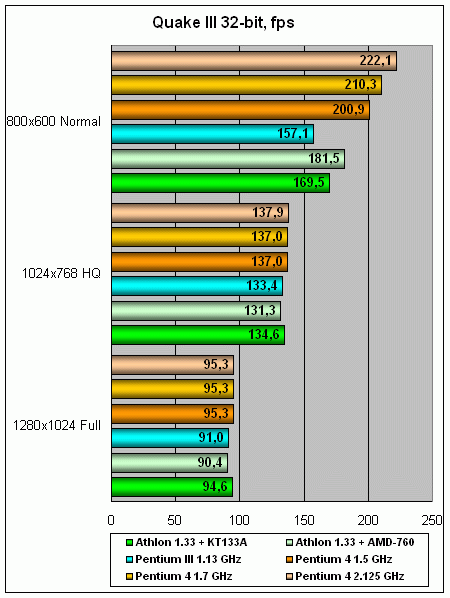 Here we can see another advantage of the Pentium 4 + RDRAM system - the acceptable realization of AGP. At 32-bit color the texture transfer speed starts influencing the overall speed, especially in High Quality and Full Option modes, since the textures become large enough. That is why only drawing them quickly from the RAM is not enough, it is also necessary to deliver them quickly to the video card. The evolution of the results (3 diagrams) shows that a team of the 400 MHz FSB and dual-channel RDRAM on the i850 based systems is supplied with a perfect realization of AGP 4X, which in combination with all this stuff doesn't hamper the system when everything is limited by the bus speed. 3DMark 2001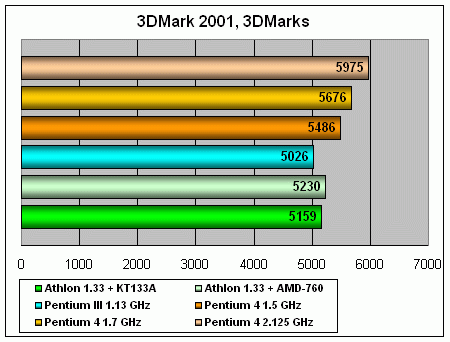  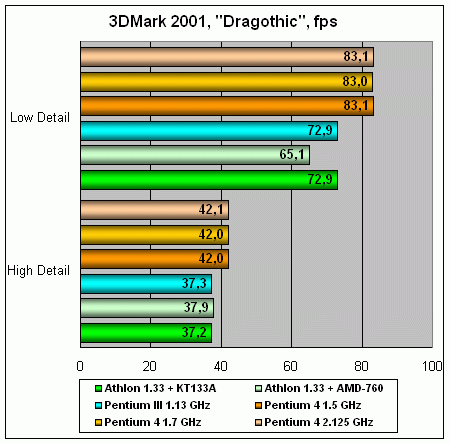 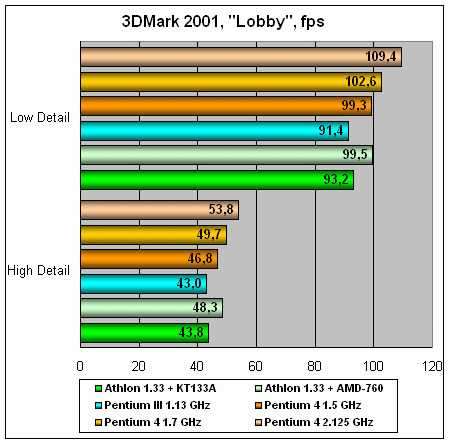 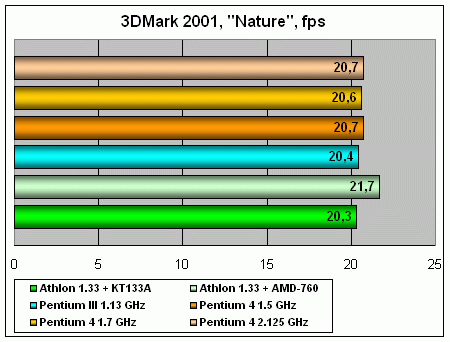 SSE, SSE2... The instruction sets seem to be very good! It is really better than 3DNow! 3DMark 2001 was always above all in enabling different hardware features, it concerns not only 3D-accelerators but all other stuff as well. Code optimization for SSE allows even the Pentium III to perform on a par with the AMD which exceeds the former in the clock speed. The Pentium 4 outperforms all the other competitors outstandingly: even the weakest Pentium 4 1.5 GHz beats the other systems. A perfect optimization for an extended instruction set and competent realization of this set in the processor bear good fruit. SYSmark 2000: Overall Score, Office Productivity, Internet Content Creation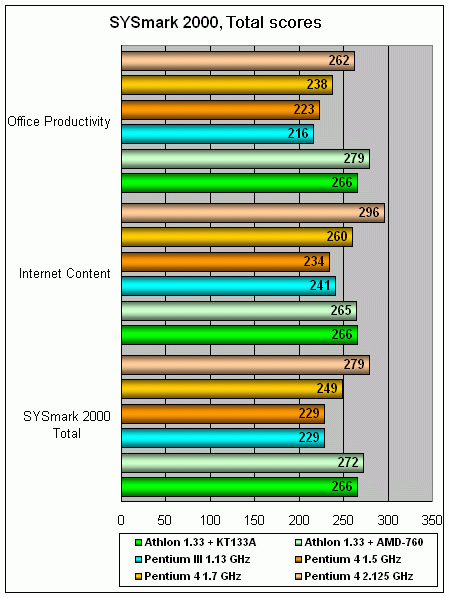 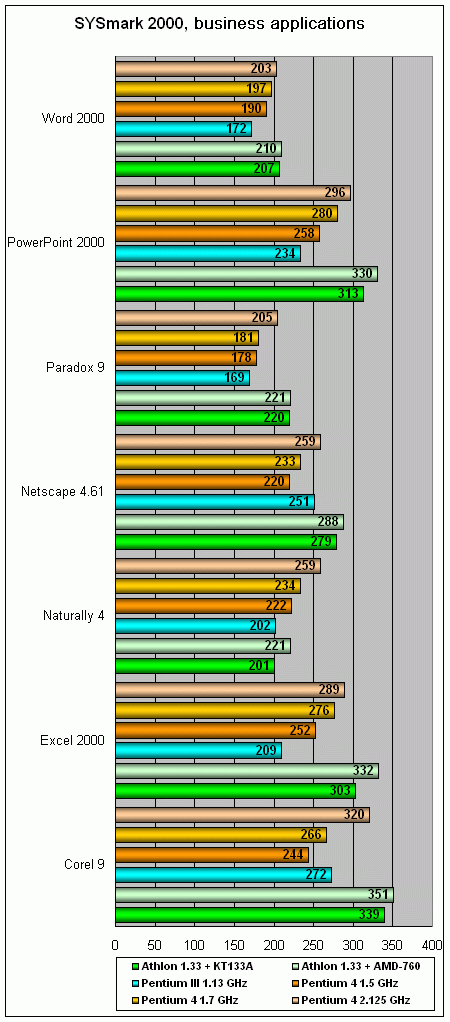 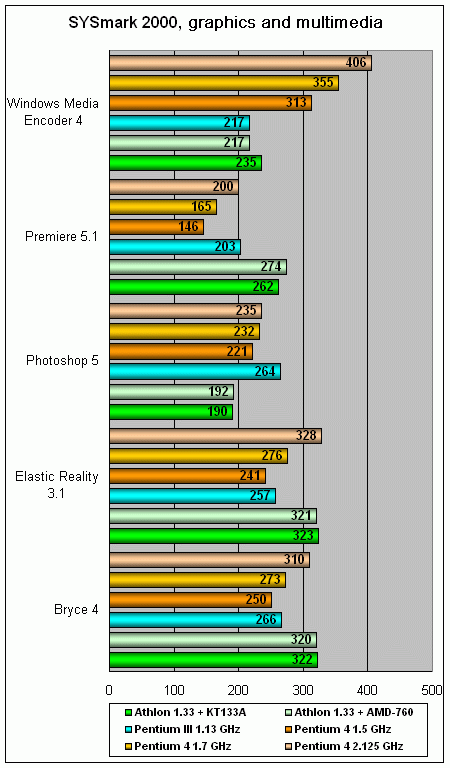 The Pentium 4 1.7 GHz is a bit worse than the Athlon but better than the Pentium III. In graphics and multimedia applications the overclocked Pentium 4 2.125 GHz is far ahead. With the frequency increase the performance of the Pentium 4 also goes up, and no limit can be seen yet. ZDM Business Winstone 2001 and Content Creation Winstone 2001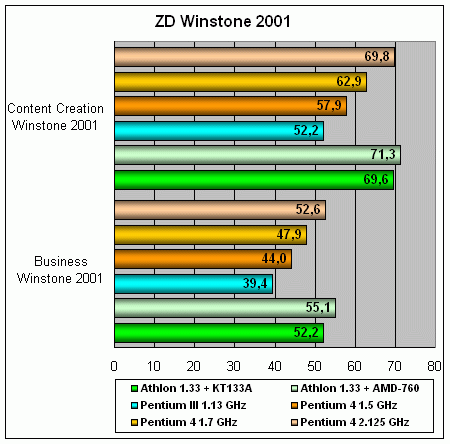 The Business Winstone test has approximately the same results as SYSmark 2000 Office Productivity in a percentage of the systems' performance levels. It is only the Pentium 4 that manages to catch up with the Athlon on PC2100 DDR. The Pentium III turned out to be the weakest. SPEC viewperf 6.1.2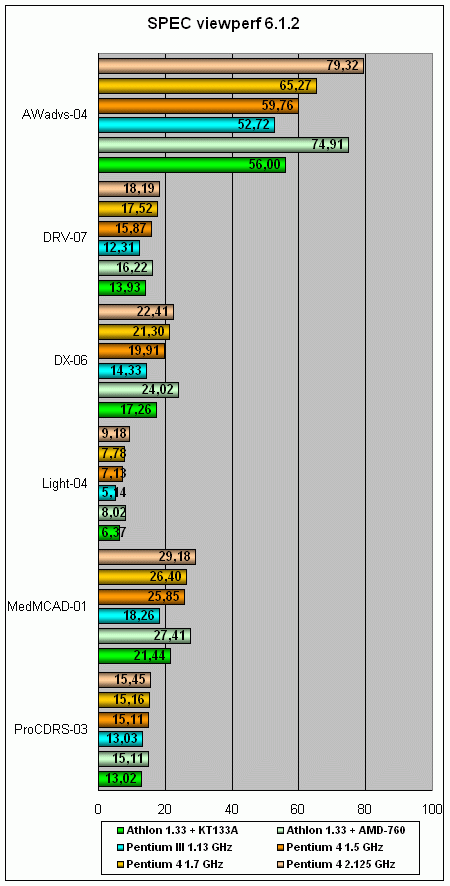 The official Pentium 4 1.7 GHz loses practically everywhere a bit, and the unofficial Pentium 4 2.125 GHz wins everywhere a little. It means that we should overclock it by all means, and Intel should produce CPUs of higher frequency based on the same core. Their performance is increasing nearly in direct proportion to the frequency. All systems equipped with usual PC133 SDRAM have fallen out of the competition. The PC800 RDRAM + Pentium 4 system had some combat with the Athlon + PC2100 DDR one, and PC133 in spite of the processors has lost the fight. 3DStudio MAX, Waterfall The higher the Pentium's 4 frequency is - the better. Again the official Pentium 4 1.7 GHz has failed to outpace the Athlon 1.33 GHz, and the unofficial Pentium 4 2.125 GHz has done it without much problems. Results in some applicationsI have chosen the most interesting results and divided them in three groups:
We are going to consider the processors not regarding the lower frequency of the Intel Pentium III and AMD Athlon. In our opinion, it makes no sense to compare processors of the same frequency. The companies have different lists of preferences, in case of the Intel Pentium 4 a frequency is in the first line of this list. Is it good or bad we'll found out after the testing. But if the market offers both a top model from AMD working at 1.33 GHz and a top model from Intel working at 1.7 GHz, it means that exactly these models show what the companies are capable of at the current stage. That is why I'm going to estimate the performance of the systems irrespective of the difference in their frequency. In our diagrams below we used the results of the official Pentium 4 1.7 GHz, and not the overclocked one. The Pentium 4 1.7 GHz wins
SYSmark 2000: Windows Media Encoder 4, NaturallySpeaking 4There have been two severe beatings of all the other systems, especially in WME. It is no secret that processing of data flows is the strongest side of the Pentium 4. It is connected, on the one hand, with a really huge processing power of the core, and on the other hand, with peculiarities of RDRAM, in which a high speed of linear operations with memory (successive reading/recording of large data volumes) goes on a par with a high latency (when accessing huge volumes of data located at different addresses). Windows Media Encoder, as a plain archiver, i.e. a program meant for converting one data flow into another, enables all the advantages of the Pentium 4 based systems very well, that is why their performance increases nearly in direct proportion to the CPU frequency. NaturallySpeaking (a speech recognition program) is also based on a data-flow technology - speech is flowing "into" the program at the actual speed, and the program has to process the sound flow and give out a text in time. Such type of programs is designed right for the Pentium 4. The Pentium III 1.13 GHz wins
SYSmark 2000: Adobe Photoshop 5One may say that the introduction of the results of non-Intel processors in Adobe Photoshop 5 lacks for a common sense. But I have included this diagram in the review because it is quite a demonstrative example. Such situation can occur when developers of a program are aimed at only one architecture winkling out everything of it and forgetting all other architectures. On the other hand, such interesting results can be achieved with such approach. The AMD Athlon 1.33 GHz wins
SYSmark 2000: Bryce4, Corel Draw 9When the AMD Athlon was released, the Bryce got famous as an application which was not in a big love with Intel's processors: the Pentium III could never beat the Athlon at the same frequency, and the Pentium 4 has failed to improve the situation. Exactly from this standpoint the result of the overclocked Pentium 4 2.125 GHz is interesting. Intel's approach has the right to exist: one should overclock the core until this CPU is the fastest. It is still not the leader here, but it is close to it... And the official Pentium 4 1.7 GHz has fallen behind the Athlon 1.33 GHz on both platforms: DDR PC2100 and PC133. In Corel Draw 9 the situation is the same: the speed of the Pentium 4 systems is growing proportionally to the frequency, but it is still lower than that of the Athlon. However, the outcome of the battle is not clear - maybe someone would release analog applications which work flawlessly with a peculiar architecture of the new Intel processor... :) ConclusionSince our last review no considerable changes have taken place, and the release of the Pentium 4 1.7 GHz hasn't presented them as well: it is only the clock speed that has been increased, in all other respects nothing has changed. Intel's position is plain: in some applications the Pentium 4 is leading now, and in those where it lags behind, the gap will be erased by increasing the clock speed to the maximum possible extent. It should be noted that this method is rational from the practical point of view - a user doesn't care what is the reason of the processor's high speed, maybe, its core's peculiar features, or its fast memory, or high CPU frequency... The 1.7 GHz Pentium 4 has done better in those applications where its predecessor had shown its might, and cut down the gap in others. The results of the overclocked Pentium 4 2.125 GHz show what we should expect to see in the nearest future, even though it is still unclear what we can get with the release of the Brookdale and VIA PX266, which are going to furnish these platforms with PC133 and DDR. In multimedia and game applications the Pentium 4 is excellent. In business ones ... but, first of all, let's decide whether the further growth of performance is necessary there. The appropriate level was already reached by the Pentium III 800EB and Athlon 800 Thunderbird. As for the graphics, the high speed is really of an utmost importance there, and the Pentium 4 doesn't always take the lead. But everything depends on the application. When some programs will be specially developed for the Pentium 4, as Adobe Photoshop for the Pentium III, then we may witness some sharp changes in the situation. And now it is difficult to give the palm of supremacy to someone. Another advantage of the Pentium 4 is that the memory access
speed is limited by no factors so far. It means that Intel can develop
processor cores of the next generations, having given the Pentium
4 to production engineers for transmitting it to the 0.13-micron
process, optimizing the core and for overclocking. Till the performance
of the Pentium 4 + RDRAM systems is not limited by the memory - each
new model with a higher clock frequency will be faster than the previous
one.
Write a comment below. No registration needed!
|
Platform · Video · Multimedia · Mobile · Other || About us & Privacy policy · Twitter · Facebook Copyright © Byrds Research & Publishing, Ltd., 1997–2011. All rights reserved. |